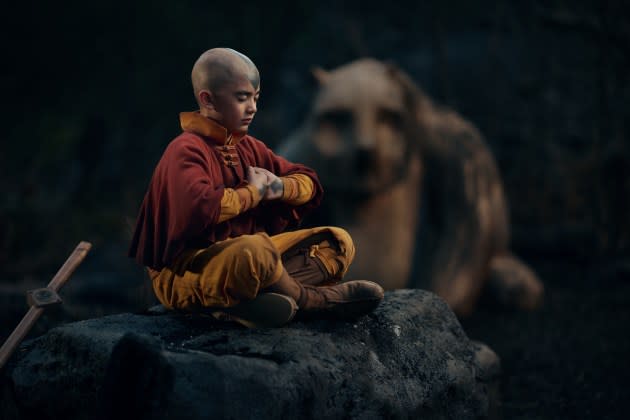As ‘Avatar: The Last Airbender’ Debuts To Strong Audience On Netflix, Creative Team Looks Ahead To Expanding Live-Action Adaptation

The results are in, and Netflix’s Avatar: The Last Airbender seems to be a hit.
The live action adaptation topped the streamer’s weekly English-language TV list with 21.2M views in its opening weekend. According to Netflix, it reached the Top 10 in 92 countries. It was edged out as most-watched title of the week by the Swedish natural disaster film The Abyss.
More from Deadline
'Queer Eye' Hires Jeremiah Brent For Season 9 Following Bobby Berk's Exit
'Heartstopper' Breakout Sebastian Croft Signs With Anonymous
2024 Premiere Dates For New & Returning Series On Broadcast, Cable & Streaming
That’s a strong showing for the eight-episode series, which was another big swing for Netflix as it continues to dip its toes into anime-inspired content. In fact, Avatar managed to surpass One Piece in its debut weekend.
As with One Piece, Netflix was firing on all cylinders to launch the series, partnering with Serena Williams and even taking over the Las Vegas Sphere. So far, the Avatar global social campaign has reached 1.53B impressions, which is on par with both One Piece as well as Netflix’s hit series Wednesday. The main trailer alone has amassed 85M views to-date, while the #AvatarTheLastAirbender hashtag has generated 1B global views on TikTok in the past week.
Avatar marks Netflix’s second successful live-action anime adaptation, after a rocky start in the genre with its adaptation Shinichirō Watanabe‘s anime classic Cowboy Bebop. While die-hard fans of any animated series are likely to have a few things to say about their live-action counterparts, the streamer appears to be finding a groove when it comes to how to bring these stories to life on the small screen.
“We’re trying to make a show for the most viewers possible. That doesn’t mean that there’s anything we’re gonna leave behind from the animated series. There’s not more purposeful deviations in order to make it acceptable for a broader audience,” Avatar executive producer and director Jabbar Raisani told Deadline. “I think it’s really attempting to be as faithful as humanly possible to the animated series, but also knowing that we have to fit it into this eight-episode, driving narrative that keeps us streaming.”
Other than missing story elements, which are obviously necessary when adapting from a 20-episode animated season of TV, one of the larger changes audiences might notice is the tone.
“There inherently has to be a tonal shift as you’re moving towards live action, because things that work in anime won’t necessarily work with real people,” Raisani explained.
While animation can often boast a more exaggerated tone, that isn’t as possible when it comes to live action.
“One of the things I did, specifically thinking of directing, was just working with the actors on different versions of the take. So with Sokka, with his humor, for example, we would do a version that was the flattest read, and then we would get more and more big and campy and over the top,” Raisani said. “Ian was great at giving a range. That allowed us in post to say, ‘Okay, let’s go funny’ or ‘We can go bigger’ or ‘Oh, man is now starting to break the tone and it feels cartoony. It doesn’t feel like he’s in the same show as everybody else.'”
Something viewers may notice remains faithful to the animated series is the dynamic camera movements, many of which came directly from the source material.
Raisani described an Episode 4 scene where Aang backflips over a boulder. Not only does the scene come from the animated series, so does the shot used to capture it.
“I literally just looked at the animated frame [and said], ‘Okay, we want to make this literal frame but with real people,” he said.
It’s a bit preemptive to say whether the series will end up among Netflix’s most popular, since the series will have a 91-day premiere window and would need more than 83M views to achieve the feat. However, it certainly bodes well for a renewal. The good news is that the creative team appears to be chomping at the bit to expand the story and address anything that might have been missing from Season 1.
“There’s stuff that we filmed that I love that isn’t in the show. There’s stuff that I love the idea of that we filmed and it just didn’t fit,” Raisani said. As a fan of the original animated series himself, he knows that audiences might be yearning for more than what they were able to fit into the first season.
“If we get another season, then we will certainly have those things, because I know what we missed now and I know how to do better the second time around,” he said, adding: “The animated series is a really good guide…for where the show can go.”
More specifically, Raisani said he’s already exploring new ways to shoot scenes that involve bending that would give the actor more agency on set and, in turn, make the final product feel more organic. He pointed to fire bending as one of the trickier elements to master, explaining that each actor had a light on their hands to emulate the fire, but they weren’t able to manipulate it themselves, which presented some restrictions.
“If they could trigger their own bending… I think we would have a more seamless product,” he mused. “So stuff like that you’ve just got to try it and then you learn and then you do it again, but better than last time.”
Best of Deadline
Hollywood & Media Deaths In 2024: Photo Gallery & Obituaries
2024 Premiere Dates For New & Returning Series On Broadcast, Cable & Streaming
2024 Awards Season Calendar - Dates For Oscars, Guilds, Tonys & More
Sign up for Deadline's Newsletter. For the latest news, follow us on Facebook, Twitter, and Instagram.
